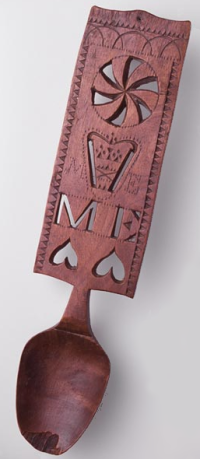
I keep coming across nicely carved antiques that were made to be useful, while the decoration shows they were designed as courtship, engagement or marriage gifts. The idea of handmade love tokens is still alive today: especially the tradition of carving love spoons. Craftspeople who make them often use longstanding folk art designs that evolved over time.
Love and commitment gifts developed in pre-industrial communities when craft skills were widespread. Men could work with wood. Women understood textiles and thread. Girls often prepared for marriage by sewing for their beloved, as well as weaving and stitching linens for their future home. Young men made something wooden that would be of value in a woman’s adult life: for instance, a knitting sheath, mangle board, or distaff.
Originally I wanted to make a list of as many different European and North American betrothal or love gift traditions as possible, but even if you limit it to Europe and European immigrant communities in the USA, and limit it to home-made carved wood, or treen, the task is still huge. Still, I’ve made a start below and would enjoy hearing more in the comments.

Spoons
Spoons have to come first: not only Welsh lovespoons like the one in the picture, but Scottish ladles and pairs of spoons linked by a carved chain, and many other regional types. Chained pairs of spoons are still known as a marriage “ritual” object in Germany. Scoops and spoons sometimes incorporated a freely-moving “caged ball” in the design. Another way of showing off the carver’s skill was to carve all the links from one piece of wood. The single piece of wood may symbolise the marriage union.
Textile tools
Knitting, spinning, and needlework aids which were carved and decorated by loving young men include knitting sheaths, famous in the Yorkshire Dales, lace bobbins, distaffs, and spinning wheel parts like the Lithuanian distaff board in the picture. Pincushions inside a carved box were made by some lovers.
Laundry tools
The Baltic countries, Russia, and parts of eastern Europe have very strong traditions of fine wood carving on the humblest domestic items. This allowed for a wide range of pre-marriage gifts even including decorative washing bats, not very well suited to modern ideas of romance since they’re only ever used for arduous, repetitive routine work. A slightly more glamorous laundry item was the classic Scandinavian engagement gift: a mangle board.
Culinary equipment

Gingerbread or cookie moulds give lots of scope for personalised carving which will look good twice over: once as an ornament on a shelf and also on home baking at future meals and social gatherings. German springerle moulds are an example. Some butter stamps were carved as love gifts. Other food-related opportunities for betrothal gifts with initials and hearts and anything else you want include rolling pins, salt boxes, and bread boards.
Dress & grooming
Stay busks and combs were once well-liked betrothal or love gifts. Stay busks, worn close to the heart, were for shaping a corset. But they weren’t always wood. Whalebone or scrimshaw busks were carved by British sailors. Some of the most elaborate folk art carving styles in maritime regions developed on long sea voyages, it is often suggested.
The finest gifts
In some regions professional wood-carvers offered a service to young men who wanted to impress their sweetheart or her family. Is this a disappointment? If I had a wonderful heirloom with my ancestors’ initials on, I would like to think it was home-made, not purchased.
Some gifts chosen by wealthy lovers are obviously not made by amateurs. Spoons and lace bobbins, for example, can be so finely-crafted and elaborate that they stand out from homemade folk art and are clearly the work of expert craftsmen. Other love tokens often commissioned by the privileged classes included combs (in the Renaissance especially) and snuff boxes given to men by women.
Photos
Photographers credited in captions. Links to originals here: Welsh love spoon, gingerbread mould, or see more picture info here.